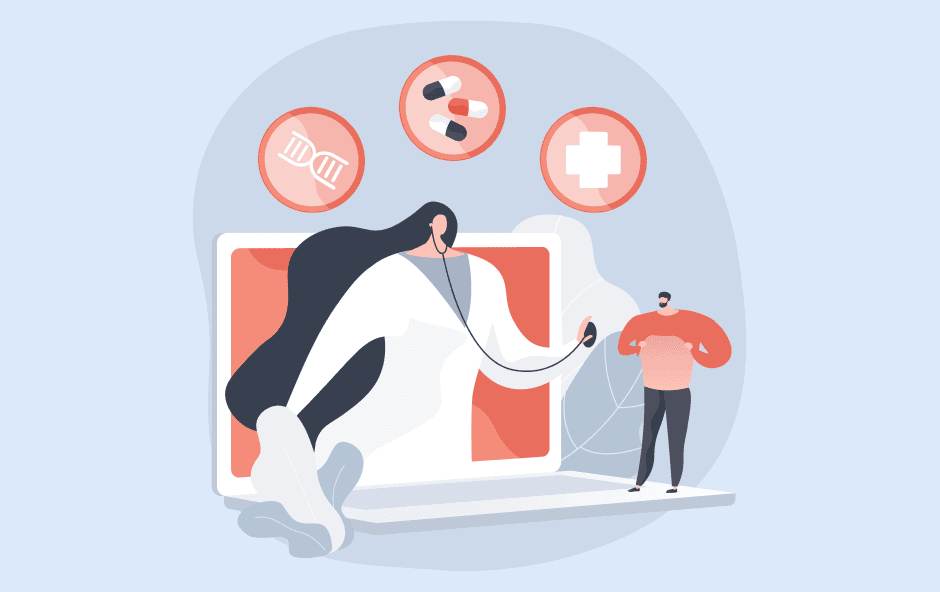The possibilities in the current digitalizing world seem limitless. These new possibilities also apply to medical devices, software, and apps. Digital applications vary from simple medical applications to software that is used in hospitals to monitor patient flows, such as the Ziekenhuisbedcheker. Examples of simple medical applications are the BreathBalanz app which helps users control their breathing or the Middin sex education app for obtaining specific information. Other examples of medical aiding applications are the Doula labor coach, JellinekMinnesota, the RIVM Tickbite awareness app, and the EFOX Parkinson’s exercises app.
All medical software and applications are categorized under the heading; 'e-health'. The aim of e-health is to improve healthcare, which may concern the quality of healthcare and patient safety, but also the speed of a specific process in healthcare. E-health seems to be very effective in most cases, for this reason, it is rapidly gaining popularity. However, there are also some risks and consequences associated with the use of e-health. For example, 'Immature' technology or faults in the network connection can create obstacles. To limit these risks, good control is important. The control of medical devices is organized in Europe through a CE(‘’Conformité Européen) -certification. A CE-mark is mandatory for all medical devices within Europe.
What is CE-certification
What is CE-certification? A CE-marking is a mark that indicates that medical devices, among other products, meet the European requirements in the field of safety, health, environmental, and consumer protection. For all medical devices in the European market, CE-certification can be used to check whether they meet the European requirements, which ensures transparency in the e-health market. A medical device containing a CE-marking is a strict requirement from the Health Care and Youth Inspectorate (IGJ), however many users and developers of e-health are not aware of this. What is CE-certification? A CE-certification is a mark, not to be confused with a quality mark. It only guarantees that a product meets the European requirements for safety, health, environmental, and consumer protection. This does not mean that a CE-certified device is by definition a high-quality device, but that it meets the European requirements and therefore is qualified as safe.
The regulations of ‘’Conformité Européen (CE) are described per product group/sector in various European directives and regulations. For medical devices, these are described in the Medical Device Regulation (MDR). For in-vitro diagnostic research, the Medical Devices Regulation for in-vitro diagnostics (IVDR) applies.
CE-certification and the associated guidelines are there to ensure that medical devices are safe. This means that the devices must not be harmful to your health, must function properly, and it should be clear how they should be used. If you as an organization implement or produce medical devices without a CE-marking, there are consequences. These consequences are imposed by the IGJ and range from an instruction or warning to a fine or order for the company to end their production of medical devices.
Do I need a CE-certification for my app?
To find out whether a tool or app needs a CE-mark, you can take the following steps. First, it must be determined in which risk classes the medical device or app is located. The MDR distinguishes risk classes I, IIa, IIb, and III. The IVDR makes a distinction in risk classes A, B, C, and D.
MDR:
| Low: risk class | Middle: risk class IIa and IIb | High: risk class III |
| All medical devices that do not fall in risk class IIa, IIb, and III. | Medical devices with the purpose of making decisions based on diagnostic or therapeutic purposes, other than the software that is classified under risk class III. | Medical devices with the aim of making decisions with the possible consequence of death or irreversible deterioration of a person's health. |
IVDR:
| Low: risk class A | Middle: risk class B | High: risk class C en D |
| Among other things, aids for collecting and storing human specimens for in-vitro diagnostics (tests with which samples from the human body, such as blood or urine, are examined outside the body). | All devices qualified under IVDR that are not classified under risk class A, C, or D. | Among other things, tools for the purpose of analyzing blood and detecting therein for the presence of a transferable reagent or blood group determination in order to guarantee the immunological compatibility of the blood intended for transfusions. |
After reviewing the above-mentioned schemes, there are three different follow-up steps possible:
The app is not a medical device, CE-certification is not required. Nevertheless, you remain responsible and accountable for providing a safe resource.
2. Low-risk class - Certification without a notified body
The app is a medical device with a low-risk class. You can certify the app yourself and do not have to have it done by a certified body.
3. Middle/high-risk class - Certification through a certified body
The app is in the middle- or high-risk class. A certified body must fully CE-certify the app.
How do I obtain a CE-mark for my software?
By determining the risk class, it has become clear whether a CE-marking applies to your device and how you must obtain it. Certification can be done by yourself or through a notified body. You can assess this yourself if the device is of a low-risk class, but for a medium or high-risk class, this must be done by a notified body. When your device is low-risk, you can draw up a technical file yourself. When the device is medium or high-risk class, the technical file must also be drawn up by a notified body. Based on this file, an EU declaration of conformity can be drawn up (a statement that the medical device meets the applicable requirements). On the basis of this statement, the CE-marking can then be obtained via Farmatec (part of CIBG). Starting May 2021, the ‘EUDAMED’ (European Databank on Medical Devices) will take care of this. After obtaining a CE-marking, the mark must be visibly, legibly, and indelibly affixed to the medical device.
After obtaining a CE-mark, it is mandatory to continuously check your medical device according to the established requirements. You do this by regularly checking the performance, quality, and safety of your device and reporting any incidents. If you want to change something, you have to update the technical file and if you have arranged your CE-certification through an external party, you must report it to your notified body as well. In case of major changes to the medical device, re-certification is necessary. Major changes could be for example, adjusting the use of the app or expanding the result of the app.
Your CE-marking for app or software
Do you have a good idea for a medical app? DTT has extensive experience in developing medical apps. We are happy to help you start the developing process and further develop your medical app. Do you already have a medical app and does your device fall into the middle- or high-risk class, but are you looking for a notified body to have your device certified? DTT is happy to help you! DTT has a wide network of partners who can help you with this. If you would like to have a medical app developed, or if you have any questions about the development of medical app software, please feel free to contact us.
Has this article made you curious to find more information about related topics? Read our other article: Healthcare apps - 17 examples. Afterward, take a look at our healthcare app portfolio.









